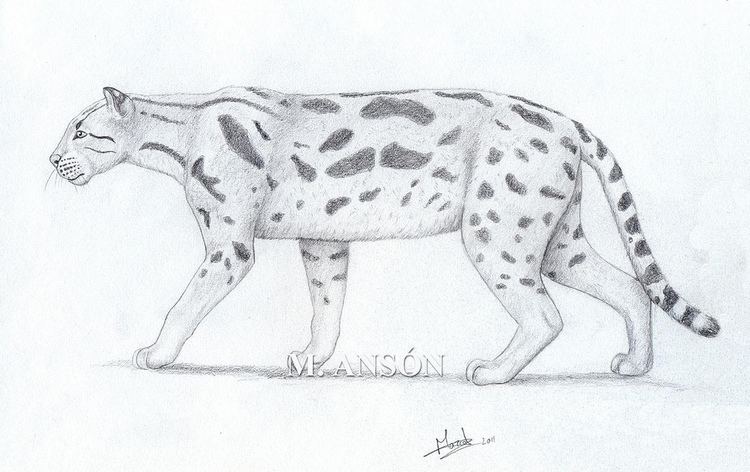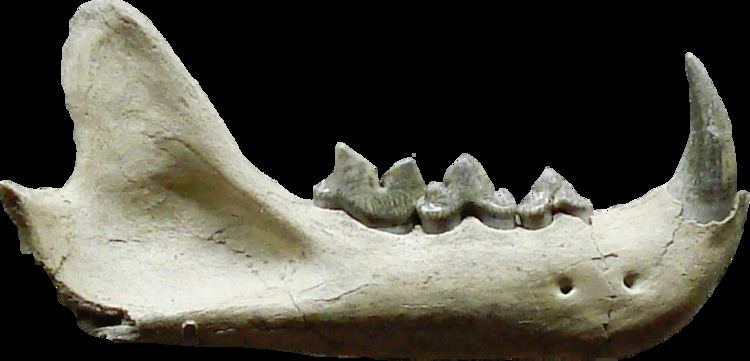Rank Genus | Order Carnivores | |
 | ||
Similar Proailurus lemanensis, Carnivores, Nimravidae, Miacidae, Machairodus | ||
Pseudaelurus
Pseudaelurus is a prehistoric cat that lived in Europe, Asia and North America in the Miocene between approximately 20 to 8 million years ago. It is an ancestor of today'S felines and pantherines as well as the extinct machairodont saber-tooths, and is a successor to Proailurus. It originated from Eurasia and was the first felid to reach North America, when it entered the continent at about 18.5 Ma ending a 'cat-gap' of 7 million years. The slender proportions of the animal, together with its short, viverrid-like legs, suggest that it may have been an agile climber of trees.
Contents
- Pseudaelurus
- Europe
- Asia
- North America
- Evolutionary significance
- Phylogeny and evolutionary developments
- References
Europe

The first and most primitive species Pseudaelurus turnauensis (=Pseudaelurus transitorius) from the early Miocene was about the size of a domestic cat and probably evolved directly from the Oligocene Proailurus. The European Pseudaelurus turnauensis gave rise to additional species. Pseudaelurus lorteti was lynx-sized and the even larger Pseudaelurus quadridentatus weighed about 30 kg and was approximately the size of a cougar. The latter showed a trend towards slightly enlarged upper canines, indicating that it may have given rise to the later saber-toothed machairodontines. Unexpectedly, the early Pseudaelurus turnauensis survived until 8 million years ago, at which time it is recorded in Germany, whereas the more derived Pseudaelurus lorteti and Pseudaelurus quadridentatus died out 2 million years earlier. A fourth European species is described as Pseudaelurus romieviensis, smaller than P. quadridentatus but larger than P. lorteti.
Asia

P. turnauensis is also recorded in Saudi Arabia from the early Miocene. P. lorteti is also recognized from the middle Miocene of Asia (Jiangsu, China), where two additional species, Pseudaelurus guangheensis from the middle Miocene of Gansu (China) and Pseudaelurus cuspidatus from the middle Miocene of Xinjiang (China) are reported.
North America

Pseudaelurus intrepidus from the Early to Late Barstovian of North America was a relatively large species, overlapping in size with the European P. quadridentatus. A second large North American species from the Early and Late Barstovian was Pseudaelurus marshi. Pseudaelurus stouti (originally described as Lynx stouti) also from the Early and Late Barstovian was a very small and slender form of the genus. Pseudaelurus aeluroides with only a type specimen from Early Barstovian from Nebraska is not well studied, but may be conspecific with P. marshi. A species Pseudaelurus validus, from the late Hemingfordian of New Mexico was described in 2001. This species overlaps in size with P. intrepidus, P. marshi and P. quadridentatus. Recently (2003) an additional North American species Pseudaelurus skinneri from the Late Hemingfordian of Nebraska was described. This species is smaller than P. validus and overlaps in size with the Eurasian species P. lorteti, P. cuspidatus and p. guangheensis.
Evolutionary significance

Traditionally all all the Pseudaelurus species from Europe, Asia and North America have been assigned to a single genus, even though the paraphyletic nature of the group has often being noted and several authorities have split Pseudaelurus into separate genera or subgenera, including Hyperailurictis, Styriofelis, Miopanthera and Schizailurus (see Werdelin et al 2010). Pseudaelurus thus represents an grade, with several different subgroups containing the ancestors to later felids.
Werdelin el al (2010) suggested dividing Pseudaelurus to represent three separate lineages, each giving rise to a different descendant group of felids. The North American species were assigned to Hyperailurictis, which is ancestral to the North American genus Nimravides. Three European species – P. turnauensis, P. loreti, P. romieviensis – were assigned to Styriofelis (junior Synonyms Miopanthera and Schizailurus), which forms the sister taxon to all modern felids, the Felinae sensu lato (i.e. including the pantherine cats). The remaining Eurasian Pseudaelurus species form a sister group to the sabre-toothed cats, the Machairodontinae.
The history of the taxonomy is summarised in the following table.
Phylogeny and evolutionary developments
The following cladogram is based on Piras et al (2013) and illustrates the three more derived lineages that evolved from "Pseudaelurus" species
